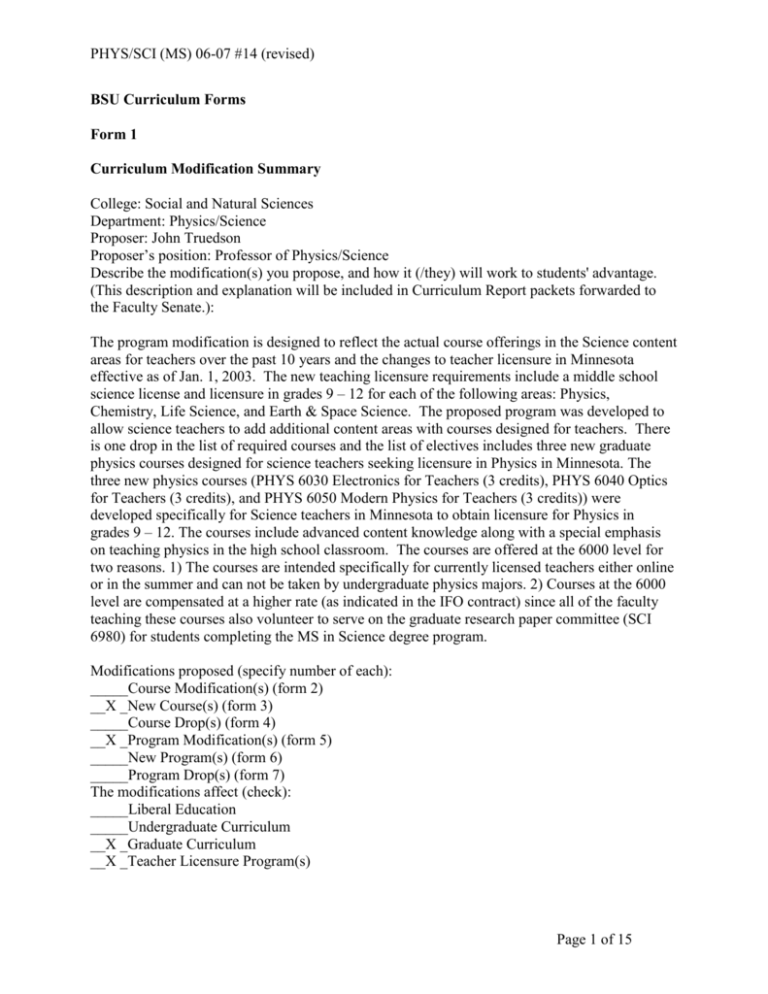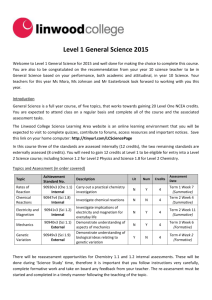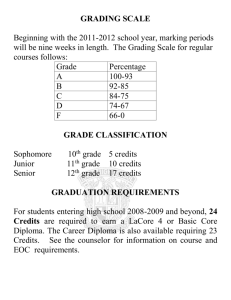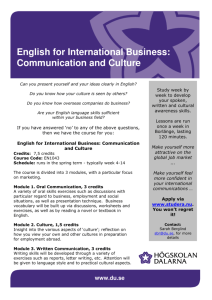BSU Curriculum Forms
advertisement

PHYS/SCI (MS) 06-07 #14 (revised) BSU Curriculum Forms Form 1 Curriculum Modification Summary College: Social and Natural Sciences Department: Physics/Science Proposer: John Truedson Proposer’s position: Professor of Physics/Science Describe the modification(s) you propose, and how it (/they) will work to students' advantage. (This description and explanation will be included in Curriculum Report packets forwarded to the Faculty Senate.): The program modification is designed to reflect the actual course offerings in the Science content areas for teachers over the past 10 years and the changes to teacher licensure in Minnesota effective as of Jan. 1, 2003. The new teaching licensure requirements include a middle school science license and licensure in grades 9 – 12 for each of the following areas: Physics, Chemistry, Life Science, and Earth & Space Science. The proposed program was developed to allow science teachers to add additional content areas with courses designed for teachers. There is one drop in the list of required courses and the list of electives includes three new graduate physics courses designed for science teachers seeking licensure in Physics in Minnesota. The three new physics courses (PHYS 6030 Electronics for Teachers (3 credits), PHYS 6040 Optics for Teachers (3 credits), and PHYS 6050 Modern Physics for Teachers (3 credits)) were developed specifically for Science teachers in Minnesota to obtain licensure for Physics in grades 9 – 12. The courses include advanced content knowledge along with a special emphasis on teaching physics in the high school classroom. The courses are offered at the 6000 level for two reasons. 1) The courses are intended specifically for currently licensed teachers either online or in the summer and can not be taken by undergraduate physics majors. 2) Courses at the 6000 level are compensated at a higher rate (as indicated in the IFO contract) since all of the faculty teaching these courses also volunteer to serve on the graduate research paper committee (SCI 6980) for students completing the MS in Science degree program. Modifications proposed (specify number of each): _____Course Modification(s) (form 2) __X _New Course(s) (form 3) _____Course Drop(s) (form 4) __X _Program Modification(s) (form 5) _____New Program(s) (form 6) _____Program Drop(s) (form 7) The modifications affect (check): _____Liberal Education _____Undergraduate Curriculum __X _Graduate Curriculum __X _Teacher Licensure Program(s) Page 1 of 15 PHYS/SCI (MS) 06-07 #14 (revised) BSU Curriculum Forms Form 5 Program Modification Form Program to be modified: Masters of Science - Science List all proposed change(s): Reason(s) for the change(s): The program modification is designed to reflect the actual course offerings in the Science content areas for teachers over the past 10 years and the changes to teacher licensure in Minnesota effective as of Jan. 1, 2003. The new teaching licensure requirements include a middle school science license and licensure in grades 9 – 12 for each of the following areas: Physics, Chemistry, Life Science, and Earth & Space Science. The proposed program was developed to allow science teachers to add additional content areas with courses designed for teachers. There is one drop in the list of required courses and the list of electives includes three new graduate physics courses designed for science teachers seeking licensure in Physics in Minnesota. The three new physics courses (PHYS 6030 Electronics for Teachers (3 credits), PHYS 6040 Optics for Teachers (3 credits), and PHYS 6050 Modern Physics for Teachers (3 credits)) were developed specifically for Science teachers in Minnesota to obtain licensure for Physics in grades 9 – 12. The courses include advanced content knowledge along with a special emphasis on teaching physics in the high school classroom. The courses are offered at the 6000 level for two reasons. 1) The courses are intended specifically for currently licensed teachers either online or in the summer and can not be taken by undergraduate physics majors. 2) Courses at the 6000 level are compensated at a higher rate (as indicated in the IFO contract) since all of the faculty teaching these courses also volunteer to serve on the graduate research paper committee (SCI 6980) for students completing the MS in Science degree program. Note: If a course from another department/program was added to this program, please notify the chair/coordinator of that course's department/program and indicate the following: The course’s home department/program was notified of the addition of their course(s) on _________ (date) by _________________ (mail, email, or phone). Note: If this is a joint program, the signatures of both department chairs (and both deans, if different colleges) must be provided. Alert: Attach copies of both current and proposed versions. Page 2 of 15 PHYS/SCI (MS) 06-07 #14 (revised) Current Program I. Required Professional Education Core Note: ED 6108 has a prerequisite not required in this program. ED 6100 Educational Research (3 credits) ED 6107 Advanced Educational Psychology (3 credits) or ED 6108 The Learning Community (3 credits) Subtotal 6 Credits II. Required Science Education Core SCI 6030 History and Philosophy of Science (2 credits) SCI 6040 Construction and Use of Demonstration Apparatus (2 credits) SCI 6110 Science Technology and Society (2 credits) SCI 6920 Directed Group Study: Science Seminar (2 credits) Subtotal 8 Credits III. Required Science Electives Select 8 of the following courses: BIOL 6020 Biotechnology for Teachers (2 credits) BIOL 6030 Field Biology (2 credits) GEOL 6010 Minnesota Geology (2 credits) SCI 6120 Physical Science for Teachers I (2 credits) SCI 6130 Physical Science for Teachers II (2 credits) SCI 6210 Meteorology for Teachers (2 credits) SCI 6220 Astronomy for Teachers (2 credits) SCI 6250 Environmental Science (2 credits) SCI 6300 Using Computers to Teach Science (2 credits) Approved electives Subtotal 16 Credits IV. Research Requirements SCI 6980 Research Paper (2 credits) or SCI 6990 Thesis (4 credits) Subtotal 2-4 Credits Total Semester Credits Required for Degree 32-34 Credits Competency Requirement A working knowledge of the applied statistics is required. This requirement may be satisfied by successfully completing SCI 6350 Computer Applications in Statistics. Page 3 of 15 PHYS/SCI (MS) 06-07 #14 (revised) Proposed Program I. Required Professional Education Core Note: ED 6108 has a prerequisite not required in this program. ED 6100 Educational Research (3 credits) ED 6107 Advanced Educational Psychology (3 credits) or ED 6108 The Learning Community (3 credits) Subtotal 6 Credits II. Required Science Education Core SCI 6030 History and Philosophy of Science (2 credits) SCI 6110 Science Technology and Society (2 credits) SCI 6920 Directed Group Study: Science Seminar (2 credits) Subtotal 6 Credits III. Required Science Electives Select 18 credits from the following: BIOL 6020 Biotechnology for Teachers (2 credits) BIOL 6030 Field Biology (2 credits) BIOL 6040 Anatomy for Teachers (2 credits) BIOL 6050 Physiology for Teachers (2 credits) BIOL 6660 Biogeography (3 credits) GEOL 6010 Minnesota Geology (2 credits) PHYS 6030 Electronics for Teachers (3 credits) PHYS 6040 Optics for Teachers (3 credits) PHYS 6050 Modern Physics for Teachers (3 credits) SCI 6040 Construction and Use of Demonstration Apparatus (2 credits) SCI 6120 Physical Science for Teachers I (2 credits) SCI 6130 Physical Science for Teachers II (2 credits) SCI 6210 Meteorology for Teachers (2 credits) SCI 6220 Astronomy for Teachers (2 credits) SCI 6250 Environmental Science (2 credits) SCI 6300 Using Computers to Teach Science (2 credits) Other approved electives Subtotal 18 Credits Page 4 of 15 PHYS/SCI (MS) 06-07 #14 (revised) IV. Research Requirements SCI 6980 Research Paper (2 credits) or SCI 6990 Thesis (4 credits) Subtotal 2-4 Credits Total Semester Credits Required for Degree 32-34 Credits Competency Requirement A working knowledge of the applied statistics is required. This requirement may be satisfied by successfully completing SCI 6350 Computer Applications in Statistics. Page 5 of 15 PHYS/SCI (MS) 06-07 #14 (revised) BSU Curriculum Forms Form 3 New Course Form Course Number: Undergraduate: Graduate: PHYS 6030 Course Title: Electronics for Teachers Course Description: A course in Electronics for high school science teachers. Credits: 3 Prerequisite(s): One year of introductory physics; Minnesota Teaching license in Science or Mathematics 1. Reason(s) for creating this course: This course is part of an alternative licensure program in physics for science teachers in Minnesota to add a physics teaching license as discussed previously in modification summary. 2. How often will this course be offered? Once a year during the summer term 3. Is this course repeatable for credit, and if so, what is the maximum number of credits that can be earned? No 4. If this course is intended primarily for off-campus delivery (not offered on campus), what delivery mechanism will be used? This course will only be offered on campus 5. What qualified faculty will be available to teach this course? Dr. David Bahr NOTE WELL: Department and dean, in approving this proposal, attest both to the adequacy of the qualifications of faculty here named, and to their availability to teach the course at the frequency specified above, without excessive overload or disruption to other curriculum. 6. What additional library and other resources need or should be provided for this course, that are not already available? None 7. What special fee(s) would be charged to students taking this course? None Amount per student: $ For: 8. Attach a sample syllabus for the course. Note: if this course is double-numbered (ugrad/grad), the syllabus must include an additional component for graduate students. Page 6 of 15 PHYS/SCI (MS) 06-07 #14 (revised) Physics 6030: Electronics for Teachers, 3 credits, Summer 2007 Dr. David Bahr 755-2916 Text: Understanding Basic Electronics, Larry Wolfgang, ISBN: 0-87259-398-3. Updated: June 24, 2006 This course is for science teachers licensed in Minnesota to upgrade their licensures to teach physics. It is intended to be taken in conjunction with the PHYS 6980 research course and will meet from noon to 3 PM, Monday through Friday, for 14 meetings. The instructional format will be hands-on lab-based, with students creating and analyzing breadboard circuits and the instructor providing explanations of technique and theory on an as-needed basis. A broad survey of practical topics will be covered, and students will wire up several common circuits of practical usefulness as well as relevance in the high school classroom. This course is only open to teachers with a current license to teach Science in Minnesota Course prerequisites: One year of introductory physics; Minnesota Teaching license in Science or Mathematics Agenda to be covered in the course: 1 Pre-test: 20 question multiple choice Charge, magnetism, conductors, insulators, fields Voltage, current; Ohm’s and Kirchoff’s laws in DC circuits 2 Capacitance, inductance, time constants 3 AC current and voltage; power circuits, transformers 4 Reactance, impedance, resonance 5 Nonlinear devices; diodes, BJTs, FETs Weekly quiz 6 Amplifiers and other linear circuits 7 Independence Day holiday – no class 8 More amplifiers 9 Op-amp circuits 10 More op-amp circuits Weekly quiz 11 Oscillators, timers and multivibrators 12 Switching theory; digital circuits 13 Project: build radio or robot 14 FFTs; LabPro heart rate monitor and computer-based EKG equipment 15 Lab quiz; Post test (final exam): 20 question multiple choice Pre-test / post-test: There will be a 20 question multiple choice exam prior to beginning the course and a corresponding post-test (final exam) after completion of the course. The score for the pre-test will be used only for assessment purposes and will not count toward the student’s grade for the class. Completion of pre-test is a required component of the course, however. Weekly Exams: The exams will be based on the questions and problems addressed in each week’s lab work. The exams will be multiple choice and short answer. You will be allowed to Page 7 of 15 PHYS/SCI (MS) 06-07 #14 (revised) use one 8-1/2” x 11” crib sheet for each exam and the crib sheet will be turned in along with the exam. Each student will maintain a lab notebook carefully documenting each of the laboratory experiences. These notebooks should contain descriptions of procedures used, data obtained, conclusions drawn, and answers to questions in the lab handouts for each of the lab exercises. These notebooks will be graded weekly on neatness, completeness and correct answers. Final Exam: The final exam will be comprehensive and will include material covered in the previous exams. The exam will be entirely multiple choice . Grades: All coursework must be submitted to the instructor on or before July 14. Grades will be awarded as follows, based on assignments turned in by the above date: Completion of pre-test (Y/N) Weekly exams (sliding scale grade) 5% 35 % Lab practice (safety, quality, completion, thoroughness) Lab quiz (sliding scale grade) 20% 10% Lab notebook (neatness, completeness, correctness) 20% Post test (sliding scale grade) 10 % Total: 100 % Page 8 of 15 PHYS/SCI (MS) 06-07 #14 (revised) BSU Curriculum Forms Form 3 New Course Form Course Number: Undergraduate: Graduate: PHYS 6040 Course Title: Optics for Teachers Course Description: A course in Optics for high school science teachers. Credits: 3 Prerequisite(s): One year of introductory physics; Minnesota Teaching license in Science or Mathematics 1. Reason(s) for creating this course: This course is part of an alternative licensure program in physics for science teachers in Minnesota as discussed in the program modification summary. 2. How often will this course be offered? Once a year on-line through CEL at the rate specified in Miscellaneous Instructional Categories. 3. Is this course repeatable for credit, and if so, what is the maximum number of credits that can be earned? No 4. If this course is intended primarily for off-campus delivery (not offered on campus), what delivery mechanism will be used? This course has been offered in the past as an experimental course using the D2L course tools. 5. What qualified faculty will be available to teach this course? Dr. John Truedson NOTE WELL: Department and dean, in approving this proposal, attest both to the adequacy of the qualifications of faculty here named, and to their availability to teach the course at the frequency specified above, without excessive overload or disruption to other curriculum. 6. What additional library and other resources need or should be provided for this course, that are not already available? None 7. What special fee(s) would be charged to students taking this course? None Amount per student: $ For: 8. Attach a sample syllabus for the course. Note: if this course is double-numbered (ugrad/grad), the syllabus must include an additional component for graduate students. Page 9 of 15 PHYS/SCI (MS) 06-07 #14 (revised) Physics 6040: Modern Optics for Teachers, 3 credits, Summer 2007 Dr. John Truedson jtruedson@bemidjistate.edu 755-2796 Text: Optics 4th ed., Eugene Hecht Updated: September 1, 2006 This course is for science teachers licensed in Minnesota to upgrade their licensures to teach physics. This course is an introduction to Modern Optics with emphasis on geometric optics. Wave optics will be introduced sufficiently to enable interpretation of diffraction, interference, and laser effects. This course is only open to teachers with a current license to teach Science in Minnesota Course prerequisites: One year of introductory physics; Minnesota Teaching license in Science or Mathematics Topics to be covered in the course: Chapter 1 A brief History Chapter 2: Wave Motion Chapter 3: Electromagnetic Theory, Photons, and Light Exam 1 on Chapters 1, 2 and 3 Chapter 4: The Propagation of Light Chapter 5: Geometrical Optics Exam 2 on Chapters 4 and 5 Chapter 8: Polarization Chapter 9: Interference Exam 3 on Chapters 8 and 9 Chapter 10: Diffraction Chapter 13: Modern optics and Lasers Exam 4 on Chapter 10 and 13 Pre-test: There will be a 50 question multiple choice exam prior to completing the rest of the course. The score for the exam will only be used for assessment purposes and will not count towards the overall grade of the class. You will be allowed to take the exam twice. Chapter Exams: The exams will be based on the questions and problems assigned for each chapter. The exams will be multiple choice and short answer. You will be allowed to use any reference materials for the exam. You will be allowed to take part each test twice with the highest score being recorded. Page 10 of 15 PHYS/SCI (MS) 06-07 #14 (revised) Internet Assignments: These assignments will utilize many of the optics-related sites available on the World Wide Web. There will be 8 assignments during the semester. I will direct you to a specific Internet URL in order to complete the assignment. You can submit assignments either with the D2L software or via E-mail. Discussions: There will be a link for discussions. I will post 7 topics (almost 1 for each chapter) during the semester to which you can respond. You will be required to participate at least twice (2) in all 7 posted discussions for a minimum of 14 total postings to receive full credit. The comments can be as short as a few sentences or as long as you wish. I encourage active participation in discussions. Term Paper: There will be a 3 – 4 page term paper for the course. The focus of the paper will be about either a real-world application of modern optics or an original classroom activity demonstrating optics principles. You will need to include all references at the end of the paper. Papers will be submitted electronically and then posted on the course web site. An optics laboratory exercise series also will be scheduled during Summer 2007 as part of the Physics Research course (currently planned for July 9- 27, 2007) along with the Electronics course. Details about the lab will be discussed later. Optics lab experiments to be covered are: 1. 2. 3. 4. 5. 6. Reflection: Plane and Curved Mirrors Refraction; Prisms, Dispersion and Total Internal Reflection Thin Lens Ray Optics: Focal Length and Magnification Telescopes and Microscopes Polarization: the Faraday Effect Grating and Single-slit Diffraction; Double-Slit Interference Grades: All coursework must be submitted to the instructor by August 23, 2007. Grades will be awarded as follows, based on assignments turned in by the above date: Completion of pre-test 4 exams: Discussion Participation Web Assignments Term paper 5% 45 % 15 % 25 % 10 % Total: 100 % Page 11 of 15 PHYS/SCI (MS) 06-07 #14 (revised) BSU Curriculum Forms Form 3 New Course Form Course Number: Undergraduate: Graduate: PHYS 6050 Course Title: Modern Physics for Teachers Course Description: A course in Modern Physics for high school science teachers. Credits: 3 Prerequisite(s): One year of introductory physics; Minnesota Teaching license in Science or Mathematics 1. Reason(s) for creating this course: This course is part of an alternative licensure program in physics for science teachers in Minnesota as discussed previously in the program modification summary. 2. How often will this course be offered? Once a year on-line through CEL at the rate specified in Miscellaneous Instructional Categories. 3. Is this course repeatable for credit, and if so, what is the maximum number of credits that can be earned? 4. If this course is intended primarily for off-campus delivery (not offered on campus), what delivery mechanism will be used? This course has been offered in the past as an experimental course using the D2L course tools. 5. What qualified faculty will be available to teach this course? Dr. John Truedson NOTE WELL: Department and dean, in approving this proposal, attest both to the adequacy of the qualifications of faculty here named, and to their availability to teach the course at the frequency specified above, without excessive overload or disruption to other curriculum. 6. What additional library and other resources need or should be provided for this course, that are not already available? None 7. What special fee(s) would be charged to students taking this course? None Amount per student: $ For: 8. Attach a sample syllabus for the course. Note: if this course is double-numbered (ugrad/grad), the syllabus must include an additional component for graduate students. Page 12 of 15 PHYS/SCI (MS) 06-07 #14 (revised) Physics 6050: Modern Physics Fall 2007 Dr. John Truedson jtruedson@bemidjistate.edu 755-2796 Text: Modern Physics, 4rd ed., Tipler & Lllewelleyn Updated: Sept. 1, 2006 This course is for science teachers licensed in Minnesota to upgrade their licensures to teach physics. This course is an introduction to Modern Physics (1900 to present). This course is only open to teachers with a current license to teach Science in Minnesota. Course prerequisites: One year of introductory physics; Minnesota Teaching license in Science or Mathematics Topics to be covered in the course: Chapter 1: Relativity 1 Chapter 3: Quantization of Charge, Light, and Energy Exam 1 on Chapters 1 and 3 Chapter 4: The Nuclear Atom Chapter 5: The Wavelike Properties of Particles Exam 2 on Chapters 4 and 5 Chapter 6: The Schrodinger Equation Chapter 7: Atomic Physics Exam 3 on Chapters 6 and 7 Chapter 11: Nuclear Physics Chapter 12: Nuclear Reactions and Applications Exam 4 on Chapter 11 and 12 Pre-test: There will be a 40 question multiple choice exam prior to completing the rest of the course. The score for the exam will only be used for assessment purposes and will not count towards the overall grade of the class. You can download the test as a PDF ahead of time. Chapter Exams: The exams will be based on the questions and problems assigned for each chapter. The exams will be multiple choice and short answer. You will be allowed to use any reference materials for the exam. You will be allowed to take part each test twice with the highest score being recorded. Internet Assignments: These assignments will incorporate the many Science Web sites available around the world. There will be 8 assignments during the semester. I will direct you to a specific Internet URL in order to complete the assignment. You can submit assignments either with the D2L software or via E-mail. Page 13 of 15 PHYS/SCI (MS) 06-07 #14 (revised) Discussions: There will be a link for discussions. I will post about 5 - 6 topics (1 for each chapter + 2 additional topics) during the semester to which you can respond to and make comments. You will be required to participate at least twice (2) in all posted discussions. The comments can be as short as a few sentences or as long as you wish. I encourage active participation in discussions. Term Paper: There will be a 3 – 4 page term paper for the course. The focus of the paper will be about the accomplishments of one person in Physics in the 20th Century. You will need to include all references at the end of the paper. Papers will be submitted electronically and then posted on the course web site. There will also be a series of laboratory exercises next summer as part of the Physics Research course (if you missed this summer the next currently planned for July 9 -27, 2007) in conjunction with the Electronics course. Details about the lab will be discussed later. The lab experiments to be covered are: Photoelectric effect Millikan Oil Drop experiment Franck-Hertz experiment Gas spectra of elements including the Bohr model of the atom Charge/mass ratio of the electron Laser Spectroscopy Grades: The course must be completed and submitted to the instructor by December 31, 2006. Grades will be determined on the following distribution based on the assignments completed by the above date: Completion of pre-test 5% 4 exams: 40 % Discussion Participation 22 % Web Assignments 23 % Term paper 10 % Total: 100 % Page 14 of 15 PHYS/SCI (MS) 06-07 #14 (revised) BSU Curriculum Forms Form 8 Signatures _________________________________________________________________ Proposer / Title / Date _________________________________________________________________ Chair or Director / Department or Program / Date Note: "All departmental recommendations [on curriculum] must be reviewed and approved by the department's faculty."--IFO/MnSCU Master Agreement 1997-1999, 20.A.3 (p. 73). _________________________________________________________________ Dean / College / Date [Note: at this point, packet goes to Academic Affairs Office.] _________________________________________________________________ BSUFA Committee Chair / Committee / Date _________________________________________________________________ BSUFA Senate Secretary or President / Date _________________________________________________________________ V. P. for Academic Affairs / Date Page 15 of 15







